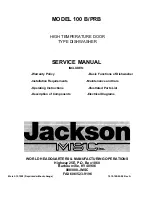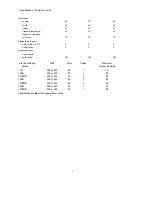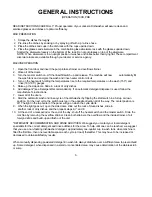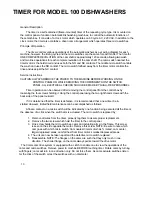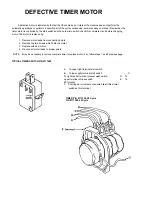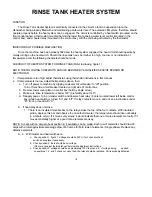
GENERAL INSTRUCTIONS
(INSTALLATION / DIMENSIONS) FOR 100B, PRB SERIES
NOTE: Read the following instructions carefully. Proper installation of your Jackson Dishwasher will assure proper
machine operation.
1. Open side doors, the front door (hook open) and remove dish, cup, and glass racks, and set to one side for
later use. Remove the tape holding the overflow strainer, the pump intake strainer, the wash head assembly
and the rinse head that are inside the machine.
2. Cut straps holding machine to base of crate, ease machine on to floor and slide into place of installation.
3. Connect drain to bottom of machine (1 1/2" IPS female fitting on bottom of wash sump) with proper slope to
conform with local and/or national codes. Drain is a gravity feed system from machine.
4. The incoming water line to the unit must be 3/4" with the capacity to supply 12 gallons per minute with a flow
rate of 20 PSI. The temperature at the unit must be 140° F. • This connection is just before the Y-strainer.
Connect to conform with local and/or national codes (STANDARDS).
5. Electrical connections should be made through hole in bottom of control box to terminal board inside (to the
right lower side of control box). This terminal board is accessible by removing the lower cover plate on control
box. The terminals are marked L1, L2 (requiring 208-230V, single phase), or L1, L2, L3 (requiring 208-230V,
three phase). There is a grounding lug inside of the control box on the bottom left. Be sure all connections
made are tightened properly. Refer to data plate for Voltage and Amperage totals and whether machine is
designed for 50 or 60 cycle operation.
6. Install the proper circuit breaker, wire, and conduit size to conform with local and/or national codes. Refer to
data plate for electrical loads.
7. DO NOT APPLY POWER UNTIL STEP 10.
8. Insert pump intake strainer and overflow strainer, then close door.
9. Turn on hand valve controlling water supply to machine; check for any leaks in plumbing
and connections.
10. To energize electrically, proceed as follows:
a. Turn on customer's circuit breaker controlling machine.
b. Check voltage at incoming terminal L1, L2, and L3 (if applicable). It should match
data plate voltage. Voltage at L1 and L2 should be checked to ground individually to
ensure that a high (or wild) leg is not connected to L1 or L2. (Voltage exceeding 150V
to ground would indicate high leg).
c. If voltages are in required range, turn on 15 amp circuit breaker on side of control
box.
The 15 amp circuit breaker protects and controls the motors and control circuit only;
it is not meant to protect or control the rinse heaters.
d. Insert a rack into the machine and close all doors.
e. Turn on the master switch; this supplies voltage to the operating controls. Then lift up on the rinse/fill
switch. The unit will automatically fill the wash tub with water to a specific level.
f. Open the front door and check the water level. It should be 1/4" below overflow level.
If not, close doors, check the incoming water line making sure that the solenoid valve
fully opens and closes as the switch is turned on and off.
g. If the water is at the proper level, with the front door closed, turn. on the heat switch.
Observe the temperature gauges; the rinse temperature should rise to the specified level
of 180° within five minutes if the incoming water temperature is 140° to the booster
tank.
h. The wash heater will take longer to reach 150°F, as the element is designed for maintaining
temperature, not heating.
i. Turn the manual wash switch on with the door closed. You should hear the water being pumped as it
strikes the top of the machine. Turn off the manual wash switch.
j. The unit is now ready to proceed with the washing of dishes in accordance with the
operating instructions in this manual, and the instruction sticker on the front door of
the dishwasher.
4
Summary of Contents for 100 B/PRB
Page 6: ......
Page 26: ......
Page 46: ...45 BOOSTER TANK HEATER ELEMENT P N 0060500 WASH TANK HEATER ELEMENT P N 0058000...

